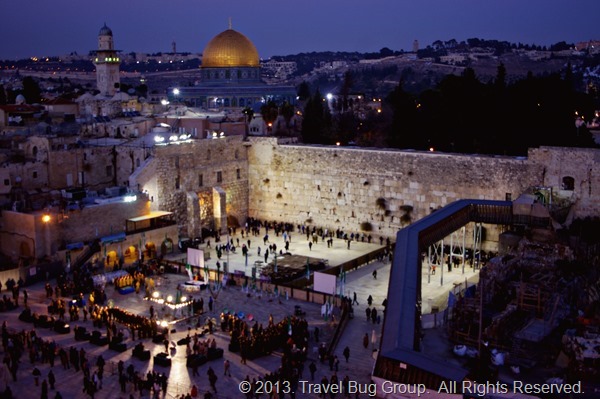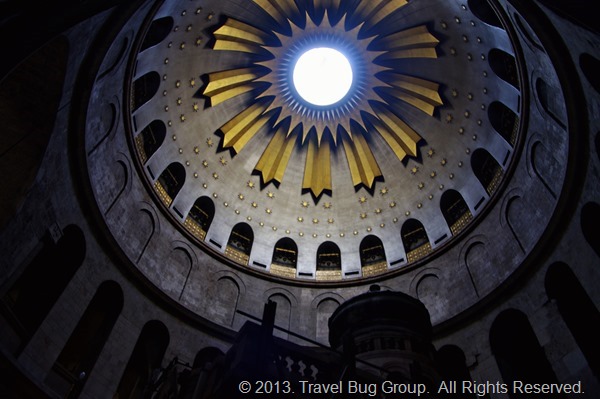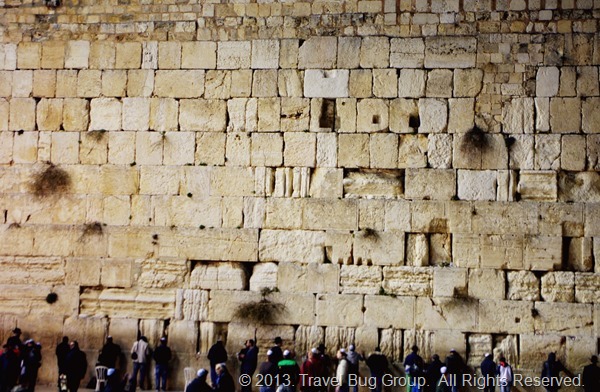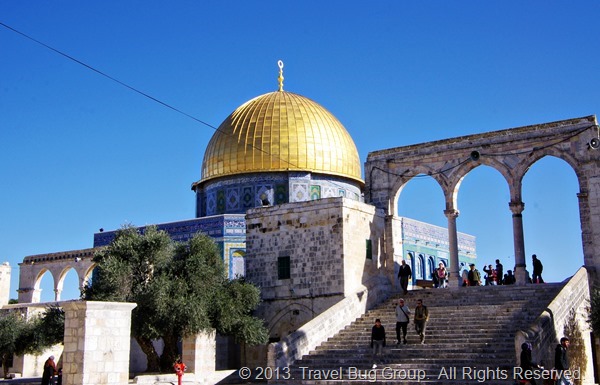Jerusalem & Religion
Posted: February 22nd, 2014 | Author: ctbideas | Filed under: ATW Updates | No Comments »
Wow, it’s been almost a month since my last posting. I’ve been working on a New Years resolution of mine called "Write 1 Submit 1" which you can read in more detail here if you’re at all interested. Suffice to say, it’s been kicking my butt. That, combined with the innumerable wonders Italy has to offer, and I’ve ended up with approximately 20+ posts queued up, all outlined out with notes, and nowhere near completion. If you’re curious about where we are (and if we’re still alive) when I’m being a slacker, I do have a nascent twitter account (@ctbideas or https://twitter.com/ctbideas for all you non-twitter folk) where I write about random things that catch my attention, plus the occasional Rick Joke which enjoy a certain cachet among those in the know. All right, enough of a Public Service Announcement. On to more interesting things.
When one think of Jerusalem, the first thing that comes to mind is usually the religious significance of this city. It is the center of 3 major monotheistic religions: Judaism, Christianity, and Islam. And the first thing I realized as I walked through the Old City of Jerusalem, is how much tension still exists between and within these three main faiths. Everyone is so careful not to offend anyone or be offended by anyone, I felt like I was stepping on eggshells everywhere we went, never knowing if we were in the right place or dressed correctly or saying the right things or accidentally offending someone with some innocuous gesture.
After a couple weeks in Jerusalem, I’ve learned a few tips:
- Always cover up. No matter the weather. That means, no bare legs, no cleavage, no shoulders (and preferably no arms) showing. Not usually a problem for a guy or in the winter, but always good to double-check for going out the door.
- Always bring along a scarf (for a girl) or a hat (for a guy). You never know when you’re going to have to cover your head out of respect.
- In many Jewish sites (and some Muslim sites depending on time), the sexes are often split. Or, in many cases, women aren’t allowed at all. So, watch for signs or notices posted.
- There is absolutely no public transportation on the Shabbat aside from taxis which takes place from about an hour before sundown on Friday to an hour after sundown on Saturday. Don’t get stranded somewhere. Don’t plan your flights around these times unless you’re willing to shell out for taxis. Most stores & restaurants are closed during this time period so you will end up with limited choices through most of the city. Plus, everything shuts down all-day Fridays in the Muslim quarter. And nothing Christian is usually open on Sundays. Plan your weekend accordingly.
- If someone comes running at you waving their hands and speaking to you in either Hebrew or Arabic, quickly exit the area. You may have inadvertently entered some place forbidden to you, which happened to us on several occasions.
With that being said, if you’re on a religious pilgrimage for one of these monotheistic religions, this is the place to be. A very cool thing about religious sites is that they’re usually free to visit (unless otherwise noted). Of course, there are SO many other religious sites contained in or near Jerusalem that we never got a chance to visit, but here are the ones we did.
Christianity
(which will have the most information, since we’re Christians)

The dome above the Tomb at the Church of the Holy Sepulchre
Via Dolorosa: the path of the cross. You can walk it on your own. It starts right on the other side of Herod’s Gate and ends at the Church of the Holy Sepulchre. Each stop has a church to visit (though a few were closed when we walked it on our own) and is marked with a Roman Numeral. If you’d like some context provided with each stop, you can follow the Franciscan procession every Fri at 3pm for free. They walk along the route followed by a giant crowd of tourists & pilgrims. One of the Franciscans carries around a speaker and at each stop, they recite its importance. At the Church of the Holy Sepulchre, around 4pm, you can follow them in another procession around the church if you’d like. It’s lovely, since everyone’s given a candle to hold for that one.
Studium Biblicum Franciscanum Archaeological Museum ($1 or 5 Shekels so depending one exchange rate): at the 2nd stop on the Via Dolorosa, the Church of Condemnation. Look for it in the corner with a small sign beside an unmarked door. It’s a small archaeological museum with a biblical significance. My particular favorite part of it was a whole wall full of apothecary jars. It’s fun to visit while waiting for the Via Dolorosa procession to begin. Open Tues-Sat 9-13 & 14-16.
Church of the Holy Sepulchre: This is one of the places where Tradition dictates that Jesus was crucified, buried, and resurrected. It’s shared by 7 different denominations: Greek Orthodox, Eastern Orthodox, Roman Catholicism, Armenian Apostolic, Coptic Orthodox, Ethiopian Orthodox, and the Syrian Orthodox. While it would seem to be a wonderful way to share a common holy place, it’s actually led to great conflicts in the past due to various denominations taking offense to other denominations’ so-called actions. Look out for the ladder perched on the second floor of the front of the church. It’s famously called the “Immovable Ladder” because someone placed it there sometime before 1839, and since no one can decide who has the right to move it, it’s stayed there all this time. Two Muslim families have been given the right to open and close the doors of the Holy Sepulchre, and this right has been retained through many generations (otherwise, the doors may never open or close). Inside, it’s beautifully decorated, culminating in a gorgeous dome over the Tomb. You will hear singing and chanting at various points. Sometimes, two factions will sing at once, louder and louder, as if to drown the other one out. Right inside the front door, there’s a stone where Jesus’ body was supposedly prepared and many people pray there or drape their holy relics there as a blessing.
The Garden Tomb: This is the other Traditional place (advocated by many Protestants) where Jesus was said to have been crucified, buried, and resurrected. Yes, there are two places. That, my friends, is the difference between fact & Tradition (with a capital T). The Garden Tomb is managed by a private organization and stands in stark contrast to the ornateness of the Church of the Holy Sepulchre. It’s a small off-the-beaten-path area within the Muslim Quarter and the inside consists mostly of gardens and a large stone tomb (which actually looks a lot like common artistic depictions of Jesus’ tomb). Whether or not I believe Jesus was buried in one or the other or somewhere entirely different, it’s a peaceful place to get away from the tension found in the rest of the Old City. Rick and I actually came here 4 different times during our 2-week stay (once for my birthday). We would find a quiet bench and spend a couple hours talking about whatever came to mind. Around us, large groups led by volunteer tour guides would go by. Sometimes, we would enjoy a small worship session by a visiting group. We actually spoke with one of the tour guides, a Canadian pastor, who likes to spend some time whenever he visits Jerusalem to volunteer here. This was definitely my favorite place in all of Jerusalem, more as a relaxation spot than for any religious significance.

In front of the Tomb of the Garden Tomb, on my birthday.
The Last Supper sites: There are also 2 sites for the Last Supper, one which is on the Mt. of Olives and one (which we visited) which is near King David’s tomb. It’s a bit hard to find since it’s within a warren of buildings, but keep asking around and one of the guards will direct you there. Truthfully, all you’ll see is a barren room with a stained glass window. But, hey, it’s fun to check it off the list.
Garden of Gethsemane & Church of All Nations: The Garden of Gethsemane site (again, remember, it’s Tradition, not fact) is in a section of the city at the foot of the Mt. of Olives which has a lot of religious sites grouped together such as Mary’s Tomb and a few convents. Of course, there are people who say Mary was taken directly to heaven, and others who say she’s buried in Ephesus, and plenty of other theories. But, I think the important thing to remember is the Idea and the Faith, than get hung up on the vagueness of facts (but don’t get me started on this topic, or I’ll talk your ear off about it) Ok, back to the Garden. It’s a small plot of about 10-15 ancient gnarled olive trees. Kind of ruining the vibe are the sellers who stand right at the entrance shilling SD memory cards, but once you get past that, it’s nice to peer through the fence at these trees. Regardless of whether they’re the correct trees, there’s no denying that these are OLD trees, and have seen much history in their lifetimes. Beside it is the Church of All Nations, so named because Christian churches from all over the world donated money to build it, reflected in the glass of the ceiling and interior mosaics. It contains the stone where Jesus supposedly prayed on before being arrested. It’s built atop an older Byzantine-era church known for its intricate floor mosaics.
Christ Church: the first Protestant church built in Jerusalem. It’s actually built in a shape of a synagogue. In fact, during the 1948 Arab-Israeli war, it was attacked by the Jordanian army who assumed it WAS a synagogue, and the then-rector had to hurry out to buy a cross to prove it was a Christian church. We went to an Anglican service here. What I enjoyed most is the small free museum out back with models of the city and other artifacts. I hear they run a decent guesthouse also.
Notre Dame of Jerusalem Center: We had Christmas Mass here, which was quite an experience. On entry, it looks exactly like any modern hotel lobby, but follow the signs to the relatively simple chapel. The mass was straightforward with a lovely message and enlivened by the end by two visiting groups from Africa who launched into an impromptu worship session/party afterwards full of dancing and singing and laughing.
Lutheran Redeemer Church: We actually didn’t visit here. However, one of our tour guides told us they have archaeological digs ongoing which you can visit for a nominal fee. Also, they offer classical music concerts. For ticket information, you can visit their website (in German…I couldn’t figure out where the English option was, if there is one)
For more information, there’s a Christian Information Center (www.cicts.org) within a block inside Jaffa Gate, next to Christ Church and across from the Tower of David.
Judaism

The Western Wall (the men’s section)
Western Wall (aka. the Wailing Wall): Before you enter the plaza where the wall is, you will have to go through security. Also, men are asked to where a kippah, the small cap Jewish men wear, on their head (loaners are available if it doesn’t squick you out). The wall is massive, stretching high above our heads. The men & women are separated. Immediately, we noted the disparity in size, with the men’s section more than twice the size of the women’s section. In each section, there’s a table in the back where one can write notes to tuck into the nooks and crannies between the stones. You don’t need to be Jewish to write a note. In fact, our guide for our walking tour told us a fun story about how the two 2004 candidates for the US presidential race came to visit the Western Wall. One tucked in a note. The other one didn’t. And the one who did won the election. Rick and I both wrote notes, which we kept secret from the other, and entered our respective sections. The women, just as numerous as the men, were all squeezed together in the front. I had to wait some time before a space opened up near me before I could get up close and personal with the wall. The wall is rough and you can see hundreds of multicolored notes everywhere. I put my note in, placed my hand against the stone, said a little prayer, and walked back. Other women sat in plastic chairs spread out in the back reading from prayer books or praying. I enjoyed the experience very much.
Kotel Tunnels (30 Shekels/person): We splurged on a tour through the Kotel Tunnles, which lead beneath the ground near the Western Wall. I’m not sure if you can visit on your own. We had to go with a guided tour, but we’ve seen other of the Jewish faith, walking through for religious reasons. At one point, on the way out, we ended up in a room full to the brim with Orthodox Jewish men as they streamed by us on their way to another section of the tunnels. Regardless, the tour is very informative. If you’re very claustrophobic, there are certain places where the hallways are quite narrow. The tour will take you underneath a large area of the city and right up against the wall which extend a large ways down. It ends at an ancient cistern, still full of water. Worth the money for us since we’re history geeks and like unique experiences.
King David’s Tomb: This is supposedly where King David is buried. It’s separated by gender Men are required to wear a kippah here also. Again, they’ll provide a free loaner if you don’t have one of your own. Women aren’t required to cover their heads, but you’ll look a bit out of place. Follow the signs for where the men and women go. You’ll enter a small room with a bookcase set to one side and the tomb, draped in green velvet, on the other. People pray there most times of the day, so keep a respectful silence. As with the Wailing Wall, the men’s side is a bit larger and more of the tomb is there (from the comparison of pictures Rick and I took of our respective sections), but both sides have a certain prayerful quality to it. (And no, King David did not build David’s tower. Herod built it. It was the Crusaders who gave the tower its moniker)
Islam

The Temple Mount (our brief glimpse)
Temple of the Mount: Non-Muslim tourists are very limited in the Muslim holy places they can visit. If you’d like to visit mosques and aren’t Muslim, Istanbul is probably a better place to go. The main place is the Temple of the Mount. There are VERY limited times when non-Muslims are allowed in. For the exact times (as I believe it changes every so often depending on the season), I suggest going to information center right inside Jaffa Gate who will not only give you free maps, but also tell you all the information you need to get inside the Temple of the Mount. Be sure to dress conservatively, no religious paraphernalia of ANY kind (crosses, Jewish stars, yin-yang, anything construed as religious), and no overt praying of any non-Muslim variety allowed if you do manage to get in. There are actually signs from the Jewish leaders which forbid Jewish people from entering. However, I believe this is a matter of the Jewish faith rather than any restriction from Muslims. You enter from an area next to the Wailing Wall, up a large wooden tunnel, and through a single special door. And go EARLY. Like 2 hours earlier than you plan to go. And remember, all non-Muslims must be OUT by the end time. I tell you this from personal experience. We waited for over an hour and a half in a long line. We managed to eke in with just under 5 minutes to go until the end time. We half-ran up the wooden tunnel and ducked through the door. Just as we raised our camera to take our first pictures, a guard ran over to us and pointed at the exit door. We managed to snap off a couple pictures rapidly, then were unceremoniously ushered out again. I’m not sure why they let us in if they were just going to ask us to leave immediately afterwards, but, hey, I don’t make the rules. We thought of going back a second time, but the line was even longer the succeeding days. I will tell you that they will let you through security even after the end time. But, don’t get your hopes up, they’ll just let you right back out another door on the other side of security without even a chance to go up the wooden tunnel, from what I’ve observed. The glimpse I had of its famous Golden Dome, however, was breathtaking. Perhaps, we’ll try again in a future visit.
Leave a Reply